KVT – Green Investigations
KVT – Green Investigations
KVT really impressed during a just-in-time visit to the main gallery at the Fine Art University, just beyond its revamped sculpture garden.
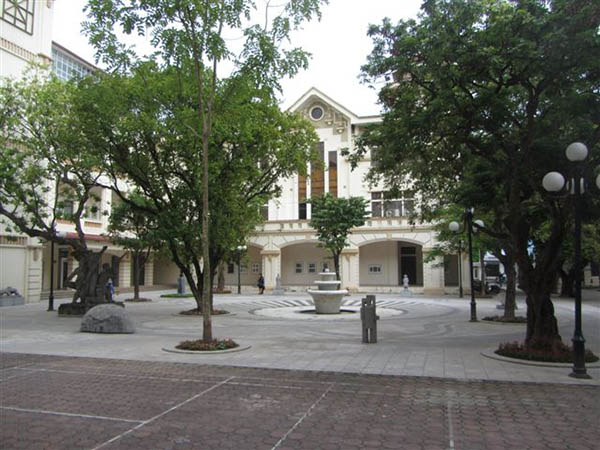
Wouldn’t you just know it!…..One of the best art exhibitions of the year comes along and I’m off warming myself at a beach haven half way down the country, 10 km south of Quy Nhon city….see here for details because it’s the info source that persuaded me to flee from Hanoi for a week of blissful warmth and peace and quiet before real rugged up winter began
The exhibition at the Art University in Yet Kieu, JOURNEY TO A GREEN VIETNAM, was only on for 6 days but I managed to catch the last wag of its tail
The exhibition, extremely nicely curated by Tran Luong who is definitely Vietnam’s premier curator and is about end of the journey impressions by a group of artists who have spent a couple of years on field trips to a variety of rural, industrial and urban regions throughout Vietnam
Hopefully most of the exhibition, or parts of it, can be re-installed for a much longer time somewhere in Hanoi. It’s one of those exhibitions that every one from school kids to adults should be encouraged to see and discuss as it raises very pertinent environmental and societal issues that need to be debated- and not just by dyed in the wool or born again greenies.
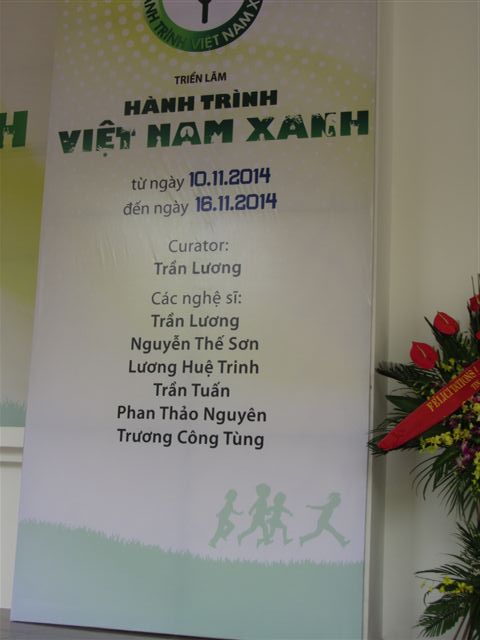
If you travel through Vietnam with your eyes and ears even half wide wide open you can’t help but be conversant with human caused environmental degradation and the impact this has on rural populations.
In an overview at one end of the exhibition are photographs, newspaper accounts and short documentary films of some of the environmental issues addressed by the six artists involved. These include……:
……legal and illegal logging and clearing of mountain forests that have caused a huge proportion of Vietnamese rivers to flow muddy and brown as top soil is washed downstream to finally silt up man made dams and natural lakes

…..building of huge dams for hydro electricity that have meant that vast valleys have been drowned and, mainly, ethnic populations forced to relocate from ancestral homelands-plus inevitable degradation of slopes that fit in with logging disasters
This valley flooding dilemma was addressed by Tran Tuan who constructed a Rong community house as used by some ethnic groups in the central highlands in his eye catching piece Roaming Raft.

His Rong house has been uprooted from the land and placed on a raft that floats above ancestral lands and ancestral burial and worship places now fathoms underwater.
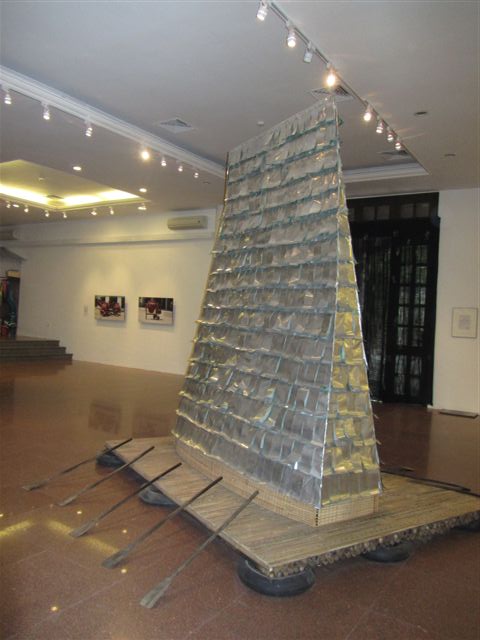
The ethnic people involved have been relocated to cement apartments and forced to abdicate from centuries old lifestyles. This dramatic lifestyle shift is referenced by the roofing of the Rong with metal rather than palm fronds- with the metal in this case being from Huda beer cans (maybe to symbolize the shifting away from communal and ceremonial drinking of home made rice wine to an immersion into globalized alcoholic cultures)
The artist’s statement is adequate and fits a host of ethnic peoples that have been relocated from drowned homelands throughout Vietnam’s mountain regions
Back to the overview…….alluvial gold mining in rivers that muddies waters and kills off fish and aquatic animal populations was illustrated
………as was forced displacement of communities from places that have sustained them to areas that are alien to them …as exampled by the relocation of people from floating fishing villages in Halong Bay
The exhibition ranges from the perfectly understated work of Tran Luong installed in two metaphorical photographs titled Museum Artifacts
and noted thus by the artist………..
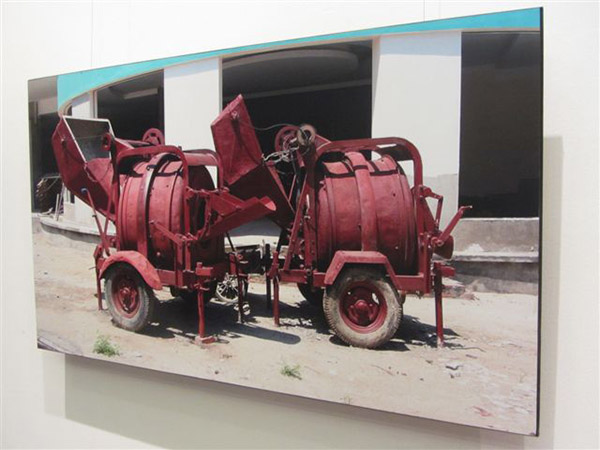
…….to the perfectly overstated installation by Nguyen The Son that illustrates through a mixed media and 2D/3D combo the living conditions of rural workers who have to migrate to urban areas to find work.
Nguyen The Son is the maestro of using photography in 3D installations and the life size one he has in this exhibition, including a walk in dwelling, would be a definite show stopper anywhere and his artist’s statement is sufficient explanation about the living conditions of ‘many farmers in a southern industrial zone who left their rice fields to come to the big city, chasing their dreams for a better future. Thousands of individual lives with hundreds of reasons to leave their home villages have gathered here sharing life together in these tiny living spaces only a few meters square next to the industrialized zone, constantly working day and night without resting. These industrialized zones are considered to be the locomotive of the train in the campaign” industrializing, modernizing” the country which has been working for 20 years since the Doi Moi (New change policy). These people – the “workers” have lived a life that doesn’t belong to them. Witnessing the struggle of their daily living condition, being trapped in a tiny room of 8 m2, I truly understand the life of these people whose days and nights directly participated in the campaign of ” industrializing” the country. What can they gain from this trade off they have made? With my “8m2 square” photography project, I would like to document the smallest corners of that living space; I would like to borrow their household daily objects, letting them speak themselves.
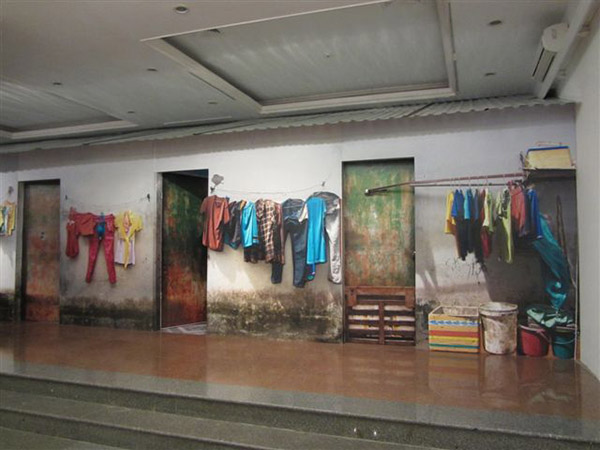
I remember 8m2 was a standard, a minimum requirement of living space for one person during the subsidized economy, or even previous to that, it was the number of living space applied to the campaign ” housing improvement” since 1954. Nowadays, after half a century struggling, many people still have to toss and turn in that 8m2 square, but it is not 8 m2 square for just one person, at times it is 8m2 for 8 people…”
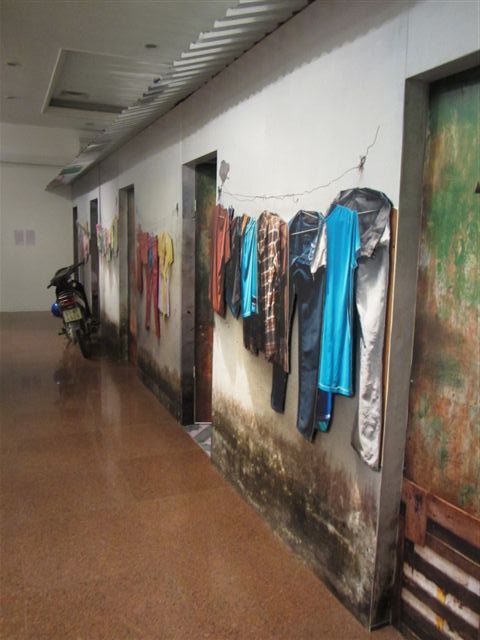
Many present and former university students from poorer families in rural areas will also recollect the same size rooms, 8m2 in which up to 4 of them would live in, sharing a bed, during their years of study. Near a few universities and colleges some land owners still convert their backyards into spaces to ‘farm’ students who exist in conditions as desperate and unhygienic as those depicted by Son.
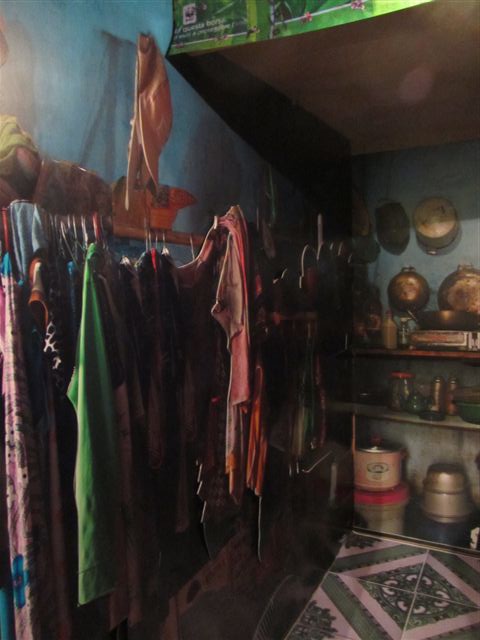
An associated installation, Illusions’ by Luong Hue Trinh has a compelling audio which is listened to while you contemplate two model sections of village rice paddy fields. This is an art work that would be extra super and a huge winner if developed into, say, real rice paddies relocated inside a distinct gallery with the sound filtering over you and around you to metaphor the despair, the fleeting dreams and wistful nostalgia.
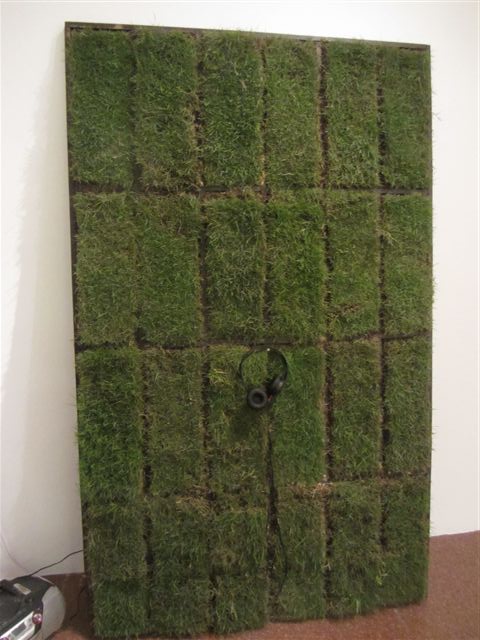
A very watch-able video installation by Truong Cong Tung is ‘Another Place Across the River’ and ends up with a surreal sequence on board a rusting hulk with a funeral band playing up beat jazz while a sword swallower does his big act right down to the hilt. It took me back 15 years ago to a brilliant Serbian movie called ‘Underground’ that deals with similar issues of displacement and corruption. Gorgeous, gorgeous, gorgeous! The juxtaposition of rural poverty and urban middle/upper class glitz was nicely put throughout
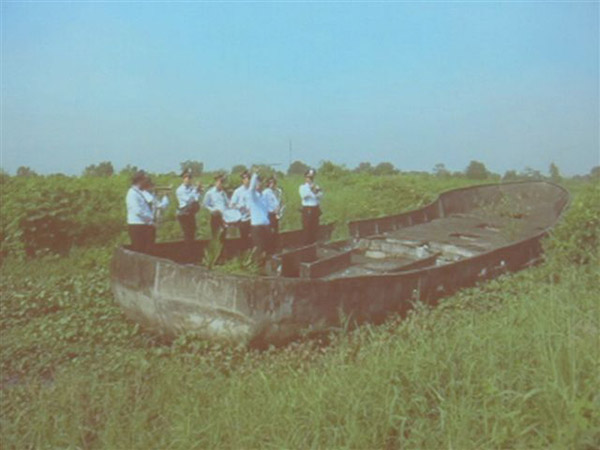
Being a collector of unique, hand made fabrics; I was really taken in by the hand woven, embroidered jute that hung across the entrance doors
The artist, Phan Thao Nguyen, has jute fabric woven and dyed by ethnic women in Cao Bang province- a practice that is now almost extinct due to the availability and cheapness of factory made nylons and plastics etc.
The scene shifts to Hung Yen province near Hanoi to a village where a jute factory was set up by the Japanese during their invasion of Vietnam in World War 2 and during which 2 million Vietnamese starved to death due to shipments of Vietnamese rice, in jute bags, to Japan. The factory is represented by a floor mounted image of stones used to separate the flax fibers and now preserved under a banyan tree…for the rest of the story read the artist’s note
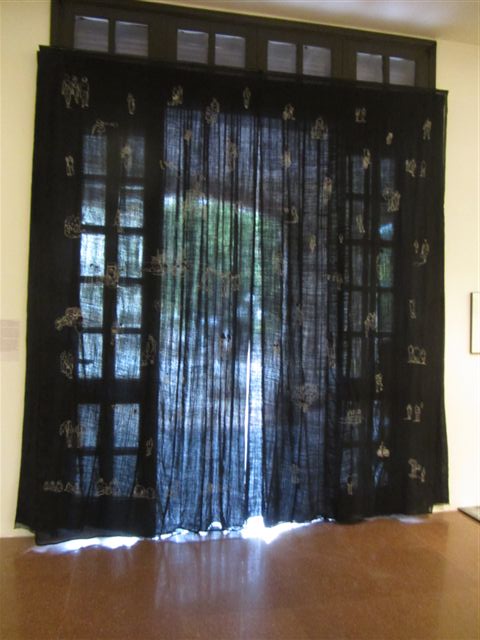
The jute is hand embroidered with silhouette figures that illustrate work in the factory- that is also now extinct

The impressive installation is titled Looking Towards Darkness and which, arguably, may reference the fact that Hung Yen is now a major industrial zone. Its rivers are just about poisonously dead from industrial pollutants, many villages have been razed to build internationally owned factories, and their uncompensated villagers pushed to dwelling in urban sprawl, or worse, and utilized as low wage factory fodder.
THE EXHIBITION CERTAINLY DESERVED A LONGER RUN OR A MUCH LONGER RE-RUN…..congratulations to all involved.
It finished on the 16th and my opinion piece would have been much more opinionated and coherent had I been around to vent my green tinged admonishments in its earlier days.